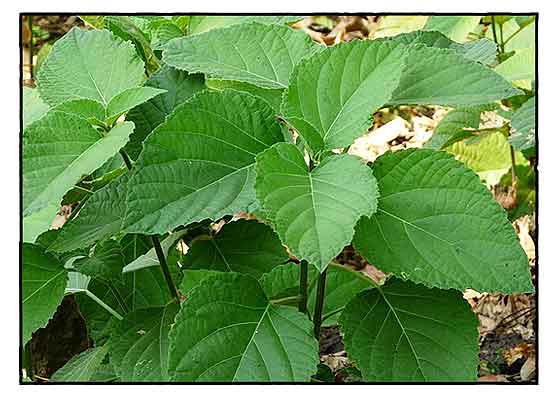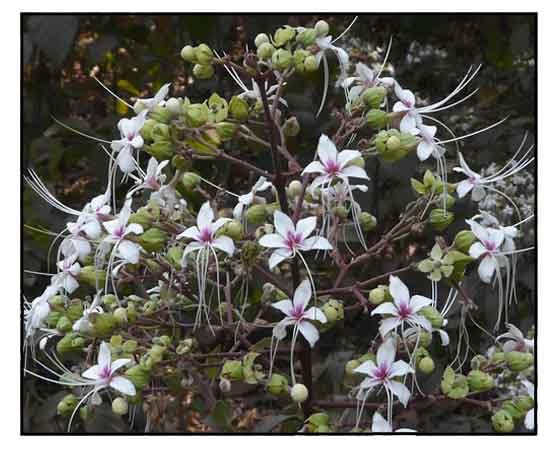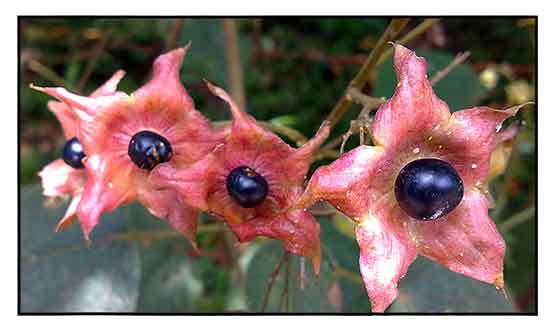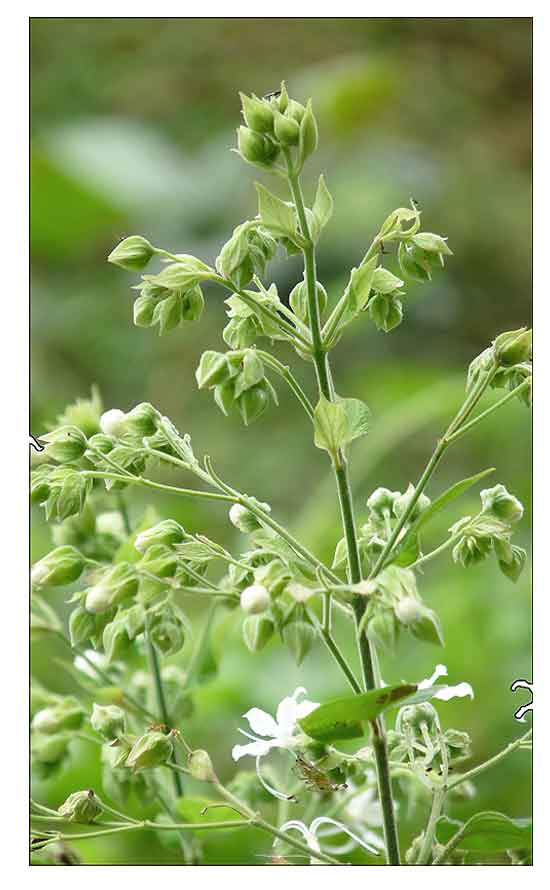 Gen info Gen info
- The genus Clerodendrum is one of the largest plant genera, belonging to the family Lamiaceae, comprising herbs, shrubs, and trees distributed worldwide.
- The genus Clerodendrum was first described by Linnaeus (1753) with one species, C. infortunatum. It was misspelled — or "Greeked" — as Clerodendron by Adanson (1763) and stayed misspelled in the 18th to early 20th century, until it readopted the Latinized Clerodendrum. It was previously placed in the family Verbenaceae, but on recircumscription of family boundaries based on morphologial and molecular phylogenic evidence, it was placed in the family Lamiaceae. (14)
-
Clerodendrum infortunatum is one of the most studied plants among the 580 species of the family Lamiaceae; one of the most important species of the genus Clerodendrum.
- Within the Malesia biogeographic region, the Philippines is identified as the center of biodiversity for Clerodendrum, the genus of glorybowers. Twenty one species are found in the archipelago, 17 are native species, six of which are endemic. (14)
- Etymology: Genus name Clerodendrum means 'chance or luck'. Species epithet viscosum means 'sticky'.
 Botany Botany
• Clerodendrum infortunatum is a shrub or treelet up to 3 m tall, nodes not annulate; leaves elliptical to ovate, 6-25 cm × 3.5-20 cm, base cordate to acute, apex acute or short-acuminate, margin denticulate or serrate, rarely entire, sparingly to densely pubescent on both surfaces, petiole 2-19 cm long. Cymes combined in a terminal panicle, 10-25 cm × 10-25 cm. Calyx tube 9-16 mm long, deeply 5-lobed, lobes up to 10 mm long, bright green or the lobes red, corolla cylindrical, tube 2 cm long, lobes 0.6-1.5 cm long, white often tinged pink at the mouth of the tube, showy, not fragrant, stamens long exserted, white to purplish, fruiting calyx accrescent to 2 cm long, red to purple. Drupe about 1 cm in diameter, bright green turning blue-black or black. (2)
Distribution
- Native to the Philippines.
- Also native to Andaman Is., Assam, Bangladesh, China, Himalaya, India, Laos, Myanmar, Nepal, Nicobar, Sri Lanka, Thailand. (1)
 Constituents Constituents
- Phytochemical screening of various extracts of leaves yielded sterols, carbohydrates, tannins, terpenoids, flavonoids, and saponins. HPTLC studies of crude extract revealed high gallic acid ( 0.244 mg/g) compared to tyrosine (0.081 mg/g). (4)
- Study of roots yielded various phytochemicals like phenol, alkaloid, flavonoid, tannin, thiamin, riboflavin, etc. Phenol yielded highest quantity (65.59 mg/g) followed by lipid (27.51 mg/g) and tannin (16.40 mg/100g.) (5)
- Phytochemical analysis of water extract of leaves yielded alkaloid, terpenoids, phenol and tannin, saponins, quinones, steroids, and glycosides, with absence of flavonoids. Petroleum ether extract yielded alkaloid, terpenoids, flavonoids, quinones. (12)
- Study of leaves yielded one undescribed jasmonic acid derivative, ten acteosides, and two flavonoids. The jasmonic acid derivative was identified as 6'-O-caffeoyl-12-glucopyranosyloxyjasmonic acid. The acteosides were identified as isoacteoside, acteoside, 2''-O-acetyl-martyonside, 3''-O-acetyl-martyonside, martynoside, brachynoside, leucosceptoside A, jionoside C, jionoside D, incanoside C. The flavonoids were identified as apigenin 7-O-glucuronide and acacetin 7-O-glucuronide. (15)
- Petroleum ether extracts of root (R) and leaf (L) yielded alkaloids (R), phenolics (R), tannin (RL), glycosides (RL), flavonoids (R), phenols (RL), coumarins (RL) steroids/terpenoids (RL), with absence of resins, proteins and amino acids, and saponins.
- Study of leaves isolated two previously undescribed diterpenoids, (5R,10S,16R)-11,16,19-trihydroxy-12-O-β-d-glucopyranosyl-(1→2)-β-d-glucopyranosyl-17(15→16),18(4→3)-diabeo-3,8,11,13-abietatetraene-7-one (1) and (5R,10S,16R)-11,16-dihydroxy-12-O-β-d-glucopyranosyl-(1→2)-β-d-glucopyranosyl-17(15→16),18(4→3)-diabeo-4-carboxy-3,8,11,13-abietatetraene-7-one (2), and one known compound, the C13-nor-isoprenoid glycoside byzantionoside B (3), along with five phenylpropanoids: 6′-O-caffeoyl-12-glucopyranosyloxyjasmonic acid (4), jionoside C (5), jionoside D (6), brachynoside (7), and incanoside C (8). (see study below) (16)
Properties
- Leaves considered anthelmintic, diuretic, emetic, tonic, antiperiodic.
- Studies have suggest antioxidant, antipyretic, analgesic, anti-inflammatory, anticancer, anthelmintic, antidiabetic, wound healing, anticonvulsant, immunomodulatory properties.
Parts used
Leaves, leaf juice, twigs, stems, roots.
 Uses Uses
Edibility
- Leaves are edible, cooked. Used as a potherb.
- In India, plant is consumed as green salad by Monpa ethnic group of Arunachal Pradesh, India. In Assam, leaves used as vegetable, and as substrate in the preparation of rice starter cake for the fermentation of rice. (13)
Folkloric
- In Ayurveda, the plant is used in postnatal care, dressing of fresh wounds, in tumors, cirrhosis, jaundice, scorpion stings, and snake bites. In Indian folk medicine, used for treatment of bronchitis, asthma, fever, diseases of the blood, inflammatio, burning sensation, and epilepsy. Plants also used for convulsions, cramps, sores, ulcers, and gravel. (4)
- In North India, widely used as a tonic and anthelmintic. In Ayurveda, Unani and Homeopathy, used for treatment of diarrhea, skin disorders, venereal and scrofolous complaints, wounds, post-natal complications, as vermifuge, laxative, and cholagogue, for removal of ascarids in the anus, and as external application for tumors. (7)
-
In the rural community of South Kerala, India, the fresh leaves are ingredients in the formulation on an herbal bath for women after delivery. In Chota Nagpur Plateau, extract from leaves applied to forehead to relieve headaches. In Bangladesh, used for helminthiasis, scabies, pain, fractures, joint displacement, diabetes and fever. In Assam, juice from leaves used to treat malaria, used as tonic to cure dysentery. Decoction of leaves and twigs taken to alleviate difficult menstruation. (13) The Kirbi tribe use raw leaves for treatment of hypertension and diabetes, while the Mishing tribe use roots and leaves for treatment of malarial fever. Root decoction used for dysentery. Juice of young leaves used to cure vomiting. Extract from tender leaves used for helminthic diseases. (17)
- Decoction of leaves used for blenorrhea. Leaf sap used as antiseptic skin wash. Heated leaves used as poultice for swollen stomach. Pounded leaves used as poultice to burns, ulcers, boils, and skin diseases. Leaves used as ingredient for herbal baths for newborn children. Juice from leaves an ingredient for herbal bath for children with furuncles. Roots used as antidote for Antiaris poisoning and dysentery and for treatment of intestinal infections and kidney dysfunction. Slender stems used as toothbrush to relive toothache. (8)
In India, leaves used for headache; ground with leaves of Commelina bengalensis and applied as plaster for sores on the head. Flowers ground with fresh shoots of Bombax ceiba, made into pills and smeared with creams from cow's milk on ulcers of the palate. Roots used for rheumatism; ground with black peppers and used for involuntary cramps. In Indo-China, decoction used for leucorrhea. (Medicinal Plants of Myanmar) (9)
- In Assam, leaves used for treatment of diabetes, deworming, dysentery. (13)
Others
- Mosquito repellent: In Orissa, India, dry leaves together with cow dung used as mosquito repellent. (13)
Studies
• Root Phytochemicals: Study of C. infortunatum roots revealed high amounts of phytochemicals, which are responsible for various medicinal properties. The phytochemicals were much higher than other reference plants. (see study above) (5)
• Anticancer / HPV-Positive Cervical Cancer / Root: Study evaluated the antitumor potential of C. infortunatum root extract invivo and invitro. The ethyl acetate extract exhibited highest cytotoxicity in a series of nine human tumor cell lines. Fractionation yielded seven compounds, which were assessed against two breast carcinoma cell lines and two cervical cancer [human papilloma virus (HPV)-negative C33A and HPV-positive SiHa] cell lines. Betulinic acid (BA) was found to be the active principle contributing to cytotoxicity. A xenograft model of HPV-positive cervical cancer in female NOD/SCID mice was use with mice treated with BA using doxorubicin as positive control. BA treatment gradually reduced tumor size, maintaining healthy hematological and biochemical parameters, and improved survival rate of tumor-bearing mice. The root extract was non toxic to normal cells. Results suggest the root extract has promising anticancer property against HPV-positive cervical cancer. (6)
• Antimicrobial / Root, Leaf, and Stem: Study evaluated the antimicrobial potency of ethanol and chloroform extracts of root, leaf, and stem C. infortunatum using disc diffusion, micro broth dilution and serial dilution techniques against clinically important life threatening organisms. All extract showed inhibitory activity against bacteria and fungus comparable to standard drugs tetracycline and fluconazole. Maximum zone of inhibition was against bacterial strains Bacillus megaterium, Salmonella typhi, and Klebsiella pneumonia and fungi Aspergills niger and Candida albicans. Potency of activity was leaf > root > stem. (10)
• Antioxidant / Root Bark / Root Bark and Leaves: A previous study of various extracts for antioxidant activity showed an aqueous acetone extract to possess the greatest activity. Bioassay guided fractionation of the aqueous extract of root bark showed the ethyl acetate fraction to be phenolic rich (264.3 mg GAE/g)and was found to possess significant radical scavenging activity by DPPH assay with IC50 of 225.2 µg/ml, which was equivalent to standard antioxidant ascorbic acid (262.5 µg/ml). (11) Antioxidant activity of various extracts of root and leaves of C. infortunatum were evaluated using DPPH assay. The ethanol extract showed more activity in almost all concentrations than other solvent extract. Leaf extract showed highest antioxidant activity of 90.65% at 100 µg/ml concentration. The ethanol extract of root showed good antioxidant activity comparable with ascorbic acid (93.13%). (19)
• Antimicrobial / Leaves: Study evaluated the antimicrobial activity of extract of C. infortunatum dried leaf powder against S. aureus and E. coli by agar well diffusion method. Zones of inhibition were 18.5 mm against S. aureus and 16 mm against E. coli. (12)
• Anthelmintic / Leaves: Benzene, ethanol, and aqueous extracts of leaves exhibited dose dependent anthelmintic activity against Pheretima posthuma in measures of paralysis and death of earthworms. The ethanol extract showed marked anthelmintic potential causing paralysis and death of worms in shorter time compared to aqueous extract and standard anthelmintic piperazine citrate. (13) In a comparative study of ethanolic extracts of Clerodendrum infortunatum and Vitex negundo for anthelmintic activity against Indian earthworm Pheretima posthuma, C. infortunatum showed more activity as compared to V. negundo. (14)
• Antidiabetic / Antiproliferative / Abietane-Type Diterpenoid Glycosides / Leaves: Study of leaves isolated two previously undescribed diterpenoids and one known compound, byzantionoside B. The three terpenoids, along with five phenylpropanoids were tested for invitro antidiabetic, anticancer, and anticholinesterase activities. Compound 6 (brachynoside) showed most potent effect against mammalian α-amylase (IUC50 3.4 µM) compared to standard acarbose (IC50 5.9 µM). As yeast α-glucosidase inhibitors, compounds 1, 2, 5, and 6 displayed moderate inhibitory activities, ranging from 24.6 to 96.0 µM, compared to acarbose (IC50 665 µM). All compounds showed negligible anticholinesterase effects. In an anticancer test, compounds 3 and 5 exhibited moderate antiproliferative effects with IC50s of 94.7 and 85.3 µM, respectively, against Hs578T cells. (see constituents above) (16)
• Wound Healing / Roots: Study evaluated the wound healing effect of topical formulations (4% w/w ointment cream bases) of petroleum ether, chloroform, and ethanol extracts on excision, incision, and dead space wound models. Effect was measured by epithelization, wound contraction, skin breaking strength and tissue granulation. Significant wound healing was observed in animals treated with choloroform and ethanol extracts, similar to reference standard drug Nitrofurazone. Histopathological exam showed increase in collagen formation. Chloroform and ethanol extract showed significant results (p<0.01). Effect was attributed to bioactive constituents, including flavonoids. (17)
• Antipyretic / Anthelmintic / Antimicrobial / Leaves: Study evaluated various extracts of C. infortunatum leaves for anthelmintic, antimicrobial, and antipyretic activities. Antipyretic activity was tested against yeast-induced pyrexia in rabbits and anthelmintic activity against Pheretima posthuma. A benzene extract showed more potent anthelmintic and antipyretic activity. Results showed antimicrobial activity of extracts against tested strains of microorganisms between concentration ranges of 75 and 350 µg/ml, with greater potency against gram positive than gram negative bacteria, with most efficacy against B. polymexia and least against P. aeruginosa. (18)
• Herbal Gel Formulation / Leaves: A previous study showed leaves of C. infortunatum have anti-inflammatory activity. Study formulated a herbal gel containing C. infortunatum leaves extract in concentrations of 2.5% and 5%, and evaluated physiochemical parameters of pH, viscosity, spreadability, etc. Results showed the 2.5% formulation has better stability. All formulations showed no skin irritation on animal model. (20)
• Wound Healing / Leaves: Study evaluated the wound healing activity of hydro-alcoholic (70% ethanol) leaves extract of C. infortunatum as 4% ointment in a cutaneous wound model in diabetic rats. Parameters measured were % wound contraction, oxidative stress related parameters (SOD, CAT, GSH, LPO), hydroxyproline content, and histopathology. Results showed significantly high % of wound contraction, significantly reduced levels of SOD, CAT, and GSH, marked proliferation of fibroblasts, more collagen deposition, well-formed capillaries, and more granulation tissue. The % ointment formulation showed faster and organized healing of cutaneous wounds in STZ-diabetic rats. (21)
• Clerodin / Anthelmintic / Leaves: Clerodin was isolated from C. infortunatum leaves and evaluated for anthelmintic activity against Pheretima posthuma. In measures of paralysis and death time, clerodin showed higher anthelmintic activity than standard Piperazine citrate (30 mg/ml). Paralysis and Death time were 4.84 minutes and 9.37 minutes for clerodin and 7.87 minutes and 13.32 minutes for piperazine citrate. (22)
• Anticancer / Ehrlich Ascites Carcinoma / Leaves: Study evaluated the anticancer activity of methanolic extract of C. infortunatum leaves against Ehrlich Ascites Carcinoma (EAC) in Swiss albino mice. Activity was measure by mean survival time, increase of life span, tumor volume, viable tumor cell count and non viable tumor cell count. Results showed increase life span of EAC treated mice with restoration of hematological parameters. (23)
• Anticonvulsant / Leaves: Study evaluated the anticonvulsant effect of ethanolic extract of leaves of C. infortunatum in experimental animals. EECI doses of 100, 200, and 300 mg/kbw i.p. were tested against MES (Maximum electroshock) induced convulsions. Phenobarbitone (10 mg/kbw) was used as reference drug. Results showed EECI 400 mg/kbw dose significantly delayed (p<0.01) the onset and antagonized MES-induced seizures. Effect could be attributed to saponin constituent. (24)
• Immunomodulatory / Leaf, Stem, Root: Study evaluated the immunomodulatory activities of 70% hydromethanolic extract of C. infortunatum (root, leaves, stems). The macrophage stimulation and plaque-forming cell numbers (using sheep red blood cells as antigen) were significantly proliferated and found optimum at 100 and 250 mg/kg doses of leaf and roots simultaneously. Extent of stimulation in humoral immunity was in the order of leaf > root > stem. Anti-inflammatory activity of Ci was confirmed by inhibition of LPS-induced nitric oxide synthesis by macrophages. Results suggest the extract has profound immunomodulation potentials in the murine model, stimulating both humoral and innate form of the immune system. (25)
• Anti-Inflammatory / Membrane Stabilizing Activity and Inhibition of Protein Denaturation / Leaves: Study evaluated the invitro anti-inflammatory activity of hydroethanolic extract of leaves of C. infortunatum by HRBC membrane stabilizing activity and inhibition of protein denaturation (anti-arthritic) activity using freshly drawn human blood and bovine serum albumin, respectively. The extract at 10, 20, 40, 80, and 100 µg/ml concentrations exhibited 46,67, 49.67, 48.33, 56.00, and 62.67% of membrane stabilization, respectively. Same concentrations showed percent inhibition of protein denaturation by 25.71, 32.5, 46.07, 57.5, and 65.36, respectively. Active principles, including flavonoids, may be responsible for the invitro anti-inflammatory activity. (26)
• Anticancer / Breast Carcinoma / Leaves: Study evaluated a 70% methanolic extract of C. viscosum leaves for anticancer properties on various cancer cell lines in measures of cytotoxicity, cell cycle analysis, induction of ROS and apoptosis, and nuclear fragmentation. Cell proliferation assay showed selective cytotoxicity of the ME leaf extract against breast cancer cell line (MCF-7). Cell cycle analysis showed increased subG1 (apoptosis) population dose dependently. There was selective ROS generation by flow cytometry. Morphological study showed condensed and fragmented nuclear structure in extract treated MCF-7 cells. Phytochemical study showed presence of tannic acid, catechin, rutin, and reserpine. The anticancer effect may be due to selective induction of ROS in breast carcinoma. (27)
• Neuropharmacological Effects / CNS Depressant / Anxiolytic / Leaves: Study evaluated the neuropharmacological effects of methanol extract of dried leaves in Swiss albino mice using Open field method, Hole cross method, prolongation effect of phenobarbital induced sleeping time and aminophylline induced convulsion in mice. The extract raised seizure threshold and exerted statistically significant dose dependent delay on onset of clonic and tonic convulsions. The ME showed significant CNS depressant activity as well as anxiolytic activity comparable to standard diazepam. In-Silico study suggests the anxiolytic activity may be due to scutellarin, xylitol, and 3-deoxy-d-mannoic lactone either alone or as synergistic effect of two or more compound interactions. (28)
• Antidiarrheal / Antidiabetic / Roots: Study evaluated the antidiarrheal and hypoglycemic activities of methanolic root extract of C. viscosum. Loperamide was used as reference standard. In Castor-oil induced diarrhea, reduction of diarrheal feces in mice was observed by 45.4% and 63.4% at 200 and 400 mg/kbw respectively. In hypoglycemic activity study, reduction of blood glucose was observed by 23.8 and 27.3% at 200 and 400 mg/kbw compared to glibencladmide (39.3%). Results suggest the roots of C. viscosum is a potential source of drugs for antidiarrheal and antidiabetic activity. (29)
Availability
Wild-crafted.
Seeds and plants in the cybermarket.
|

![]()







